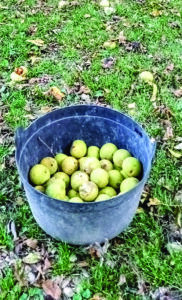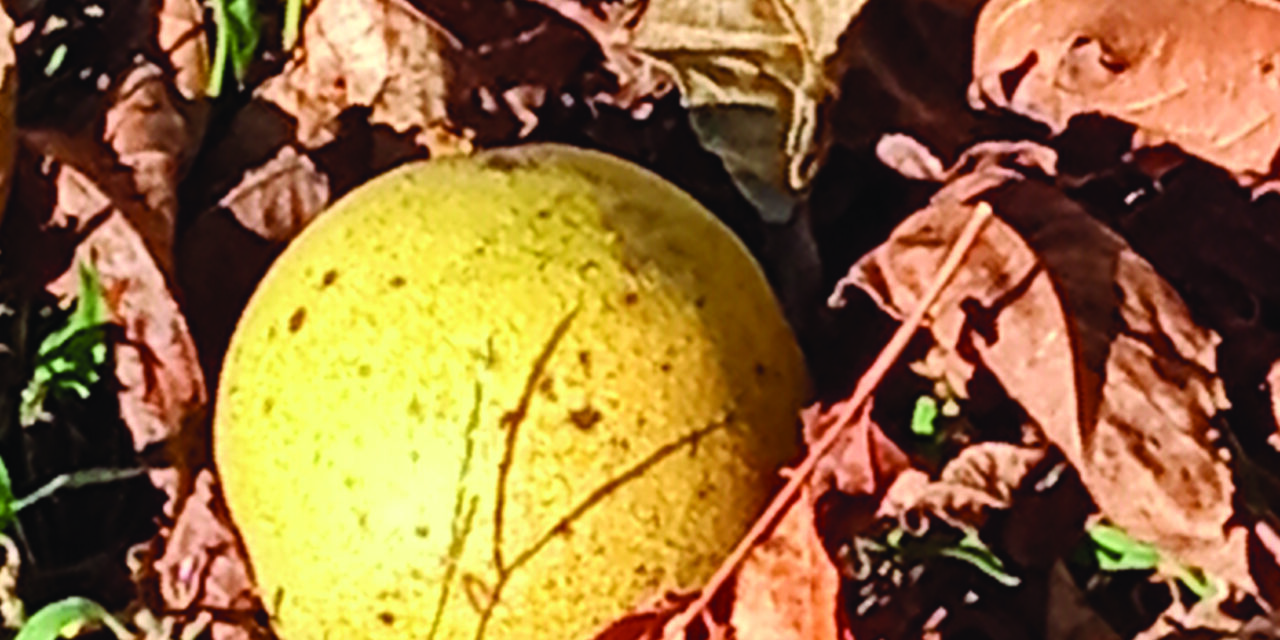
After falling from trees in October, apple- sized Black Walnut hulls resembling greenish tennis balls fall to the ground where they slowly decompose, releasing, but not breaking open, the tough to crack shelled nut. (Photo by Debra Messick)
Along with the gently welcoming cascade of falling leaves, autumn sometimes arrives with arresting thumps, followed by clumps of greenish tennis ball sized objects.
Those are black walnuts, landing amid the softly crunching brown, gold, and scarlet foliage carpet, if not atop unsuspecting, unlucky heads.
Besides our own Mid-Atlantic and other Eastern U.S. and Canadian areas, this seasonal yard bombardment has also been an annual occurrence throughout the Midwest, Ozarks and Appalachia.
For kids tasked with clearing the relentlessly accumulating droppings from lawn and garden each October, they might be regarded more as a nuisance than a hoped for harvest.
But ask a friend about the rich flavor of black walnut ice cream, and a variety of other traditional delicacies, and their attitude may change.
The far more familiar English walnut, though easier to crack, isn’t nearly as prized, taste-wise. The more costly import was also often outside the frugal budgets of previous generations, for whom it made practical sense to somehow harvest the home-grown black walnut.
With grocery prices steadily rising, it may be worth tackling the challenging questions offering the key to reaping the awaiting black walnut bounty.
When and how do you safely remove the thick outer hull and burrow through the skin-staining matter beneath it?
According to Toronto nonprofit Not Far From The Tree, dedicated to harvesting otherwise wasted wild growing fruit, here’s how to tell when black walnuts are ready to harvest:
“When the husk is brown, is cracked, gives in to pressure, or peels away easily from the nut inside. Walnuts that are still green on the outside are OK to pick, but require more work to get to the nut meat. Crack open a few nuts to see if the husk peels away easily from the nut but be careful as the ink inside stains very quickly and is hard to get rid of.”
Once you manage that, though, who besides the hardy squirrel, woodpecker, or fox can effectively crack the tough-as-nails shell of the nutritious and truly delicious nut meat within?
Dorchester County Master Gardener Kathy Burtman still remembers her father attempting to run over them with his vehicle, back and forth, in an effort to release the precious nut meat.
Today, homesteaders, foragers, and the intrepidly handy have devised a variety of methods, generously sharing their efforts on YouTube.
Vermont homesteader Ashley Adamant, who publishes the blog Practical Self Reliance, last October posted a column on How to Crack Black Walnuts, stating:
“They are a very hard nut, and no, you’re not going to easily crack them with one of those simple tabletop nutcrackers you see in a bowl of holiday nuts on the coffee table at Christmas time. That is just not the best tool for the job, and if you try to crack them that way you’ll likely come to the conclusion that Black Walnuts are impossible to crack.”
Her own tested recommendations involve a strategy of finesse.
“Believe it or not, the best way to crack black walnuts is not to crack them at all. Brute force isn’t the solution to everything, and sometimes the best option is to work smarter, not harder,” Adamant advised.
While people used to have a variety of nut picks on hand, if you don’t, a small Flathead screwdriver, nail, or pocketknife will help the process. But an equally important tool she’s discovered to get the job done is plain old patience (which some may suggest is another rare modern commodity).
“Black walnuts need to first be husked to remove their spongy green outer husk, but then they need to be dried for several months until their hard shell begins to split on its own. When they’re fresh, the shell is not quite so dry and brittle, and they’re incredibly difficult to crack (and impossible to pick open, since there’s no crack to get your tool into). Wait a few months and they’ll start to open on their own, and that’s the perfect time for a nut pick.”
Adamant summarized her simple but effective method this way:
• Husk the nuts as soon as possible after harvesting;
• Clean the black walnuts as best you can;
• Lay the black walnuts out in a well ventilated spot to allow them to dry (but protected for rodents and squirrels); and
• Once they’ve dried for a week or two, store them in a place with good airflow and they’ll continue to dry until they start to split open on their own.”
In some cases, though, others can help supply the skills, know how, and specialized equipment to tackle the tough job involved in reaping the potential reward from our only native growing nut tree.
Not Far From The Tree is Toronto’s fruit tree harvesting program, founded in 2008, whose mission is to help pick fruit in people’s yards, sharing the bounty with organizations that feed Toronto residents.
According to the group’s website,
https://notfarfromthetree.org, “When a tree owner can’t keep up with their harvest, we mobilize a volunteer team to pick the fruit, and then split it ways: one-third to the tree registrant, one-third split amongst the volunteers, and one-third donated to one of our social service agency partners.”
If you truly want to access Black Walnut taste without all the trouble, 4th generation Missouri family enterprise, Hammons Products Company, now a renowned world leader in the field, offers several solutions.
According to Jacob Basecke, Executive Vice President and great grandson of Missouri grocer Ralph Hammons, who started the company in 1946:
“Folks gather freshly fallen black walnuts during the month of October and early November and bring their loads (still in the green husk) to one of 180 hulling stations across 13 states in the Midwest; after the green husk is removed, they are paid on a per pound basis. This year our opening price is $16 for 100 pounds and all quantities are acceptable. It could be a single five gallon bucket or it could be an entire truck bed full,” he added.
“Typically once the nuts have fallen on the ground, they are ready to be harvested.
For optimal quality and taste, it is best to gather them and turn them in quickly while the husk is still nice and green,” Basecke advised.
“There are tens of thousands of folks that take part in the annual Black Walnut Harvest and they all do it for different reasons.
Some people do it to earn extra money, while others love the joy of spending an afternoon with their kids or grandkids and showing them the value of hard work.
Several people also participate in the harvest to simply clean up their yard or land. The best thing about the Black Walnut Harvest is the memories that are shared with family and friends,” he noted.
“For decades, Black Walnuts were primarily used as an ingredient nut in ice cream and baking. We continue to sell into these markets, however, we are seeing consumers use them in a variety of ways including salads, side dishes, oatmeal, trail mixes and many other applications. The versatility of Black Walnuts is one of their many benefits.
When folks are comparing Black Walnuts to the more common English walnuts, the first thing is the flavor. Black Walnuts have a bold, earthy, almost fruity like flavor that is unlike any other tree nut,” he offered
“What also makes them unique is how they are sourced. Black Walnuts are grown from wild, uncultivated trees and gathered by hand from locals across the Midwest. English walnuts are grown in large orchards in California and mechanically harvested. This story on sustainability has gained a lot of traction that consumers are noticing. Black Walnuts have the highest protein than any other tree nut along with being a good source of poly and monounsaturated fats, fiber and other vitamins and minerals,” Basecke mentioned.
“Over the years, we have invested in new shelling equipment to make it more efficient for the shell and nutmeats to be separated after cracking, which is a key step in our production. This new technology uses laser sorters to separate the shell and nutmeat and does a pretty efficient job. After the product goes through the laser sorters, the nutmeats are separated by size and then visually inspected by hand to ensure no remaining shell is left,” he added. “This step of inspecting the product by hand has been part of our process since we first started in the 1940s and remains a critical step today in our production.”
If you’re still looking for reasons to savor your black walnut bounty, here are a few to chew on:
From the Arbor Day Foundation:
“Practicality and aesthetics combine in the black walnut to make this species one of the most treasured trees in American history. The valuable dark brown wood is strong with a handsome grain that polishes easily and gleams forever. And the rich, flavorful nuts are enjoyed fresh and retain their flavor and texture during cooking.
This native tree has been called our best friend in times of war and peace. Native Americans and early settlers used it for food, dyes, ink, medicine, fence posts, gun stocks and furniture.”
From Towson University’s Glen Arboretum:
• The walnut shells were used during WWII to clean airplane pistons. The idea was then transferred to the automobile industry to deburr gears; and
• The black outer husk of the walnuts can stain skin and clothes and was used as a dye by some Native Americans.
From the USDA Forestry Service via the University of Nebraska-Lincoln, cites researcher and author Daniel E. Moerman with black walnut’s health aspects.:
“Historically, the bark of black walnut was used by several Native Americans, including the Cherokee, Delaware, Iroquois, and Meskwaki, in tea as a cathartic, emetic, or disease remedy agent, and chewed or applied for toothaches, snake bites, and headaches. Caution: the bark should be used cautiously in medicine because it is poisonous. The Cherokee, Chippewa, and Meskwaki also used the bark to make a dark brown or black dye. The Comanche pulverized the leaves of black walnut for treatment of ringworm, the Cherokee used leaves to make a green dye, and the Delaware used the leaves as an insecticide to dispel fleas. The nut meats were also a food source for Native Americans, and the nuts are still consumed today by people and are an important food source for wildlife.”




